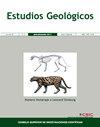Somosaguas中新世T1段啮齿动物标本的横向异质性(Pozuelo de alarcon,马德里)
IF 0.8
4区 地球科学
Q3 GEOLOGY
引用次数: 3
摘要
啮齿动物的关联通常用于古环境推断。假设地层水平内化石含量的横向均匀性,有时使用这种组合中包含的物种的相对丰度来进行这些推断。然而,这种同质性从未在同一化石层内的物种比例中进行过经验检验。因此,在本研究中,我们比较了来自Somosaguas化石遗址(中新世中期)T1层的两个样品,它们横向相距30 m。虽然从定性的角度来看,这两个样本显示出相同的区系组成,但通过蒙特卡洛随机化实现的分析表明,两个样本之间不同物种的相对丰度存在显着差异。这些结果可能是由于1)不同物种牙块的沉积行为不同,因为大小不同;2)索萨瓜斯T1层沉积物样品体积小,化石遗存密度高;3)与连续冲积扇的存在有关的差分时间平均,与阿拉贡期环境变化引起的种群变化有关。我们的结果表明,当古环境推断是基于小哺乳动物物种的相对丰度时,需要谨慎。本文章由计算机程序翻译,如有差异,请以英文原文为准。
Heterogeneidad lateral en las muestras de roedores del tramo T1 del Mioceno Medio de Somosaguas (Pozuelo de Alarcón, Madrid)
Rodent associations are habitually used in palaeoenviromental inferences. Assuming lateral homogeneity in fossil content within stratigraphic levels, sometimes these inferences are performed using the relative abundances of species included in such associations. Nevertheless, this homogeneity has never been checked empirically in species proportions inside the same fossiliferous level. Because of that, in this work we compared two samples from T1 level of the Somosaguas fossil site (middle Miocene), which were separated laterally by 30 m. Although both samples show identical faunal composition from a qualitative viewpoint, analysis realized through Monte Carlo randomizations indicated the existence of significant differences in relative abundances of different species between the two samples. These results could be due to 1) different sedimentary behaviour of dental pieces from different species due to differences in size; 2) small size of sediment samples combined with high density of fossil remains in level T1 of Somosaguas; 3) differential time averaging related to presence of successive alluvial fans, associated to population changes due to environmental changes during the Aragonian. Our results show the need of cautiousness when palaeoenviromental inferences are based on relative abundances of micromammalian species.
求助全文
通过发布文献求助,成功后即可免费获取论文全文。
去求助
来源期刊

Estudios Geologicos-Madrid
GEOLOGY-
CiteScore
1.40
自引率
14.30%
发文量
6
审稿时长
>12 weeks
期刊介绍:
Since 1945 Estudios Geologicos publishes original research works, as well as reviews, about any topic on Earth Sciences.
Estudios Geologicos is published as one yearly volume, divided into two half-yearly issues. It is edited by the Spanish National Research Council (Consejo Superior de Investigaciones Científicas, CSIC) at the Instituto de Geociencias (CSIC-UCM).
Estudios Geologicos provides free access to full-text articles through this electronic edition. Accepted articles appear online as "Forthcoming articles" as soon as the galley proofs have been approved by the authors and the Editor-in-Chief. No changes can be made after online publication.
 求助内容:
求助内容: 应助结果提醒方式:
应助结果提醒方式:


